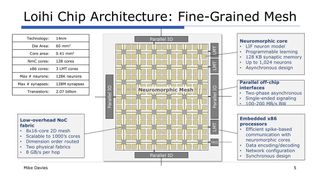First Global 500 Companies Join Intel Neuromorphic Research Community
Building a coalition around research.

Intel last month announced the first public companies that have joined its Neuromorphic Research Community. The quartet includes Accenture, Airbus, GE and Hitachi, which will perform research and create real world proof-of-concept applications.

The companies' membership indicates the growing commercial interest in the technology and its advancing maturity. Intel further disclosed that the Intel Neuromorphic Research Community (INRS) has more than tripled in size compared to last year to over 75 members, spanning universities, government labs and start-ups.
The companies aim to develop real world applications with Intel's Loihi, a self-learning neuromorphic research test chip introduced in November 2017.
- Accenture, which works with most Fortune 100 companies, will explore how it can help enterprises with artificial intelligence through specialized and heterogeneous computing.
- Airbus will use it for its (lesser known) cyber security activities and expects that Loihi’s real-time learning capabilities will help it with faster, more accurate and low power malware detection, in particular in the fight against ransomware.
- GE will research how it can leverage Loihi to improve industrial operations, such as adaptive controls and autonomous inspection and unlock new capabilities, such as real-time inline compression.
- Hitachi sees Loihi’s potential in recognizing time series data of camera sensors and edge computing systems.
Neuromorphic computing is still largely a field of research. While several companies have already created neuromorphic chips, including Intel’s Loihi and IBM’s TrueNorth, it is still a long way off from commercialization and widespread adoption. Intel thinks neuromorphic computing can become an important market and has cited analyst forecasts of growth from $69 million in 2024 to $5 billion in 2029 and even $21.3 billion in 2034.
Intel established the INRS in early 2018, shortly after it manufactured its first 14nm Loihi prototype neuromorphic chips with 130,000 neurons. Since then, Intel has scaled up Loihi to systems with 64 chips – and has 768 chips on the roadmap. With its effort to create an active field of research around Loihi and neuromorphic computing, Intel hopes to lead the field of neuromorphic computing towards commercialization.
Contrary to conventional deep learning that is based for a large part on brute force compute, neuromorphic circuits aim to implement neural activity closer to their biological counterparts. For instance, they implement otherwise uncommonly used asynchronous circuits (called spiking neural networks), where transistor switching is not governed by a global clock. They could potentially improve the energy efficiency of certain tasks by orders of magnitude.
Stay on the Cutting Edge
Join the experts who read Tom's Hardware for the inside track on enthusiast PC tech news — and have for over 25 years. We'll send breaking news and in-depth reviews of CPUs, GPUs, AI, maker hardware and more straight to your inbox.
Most Popular



